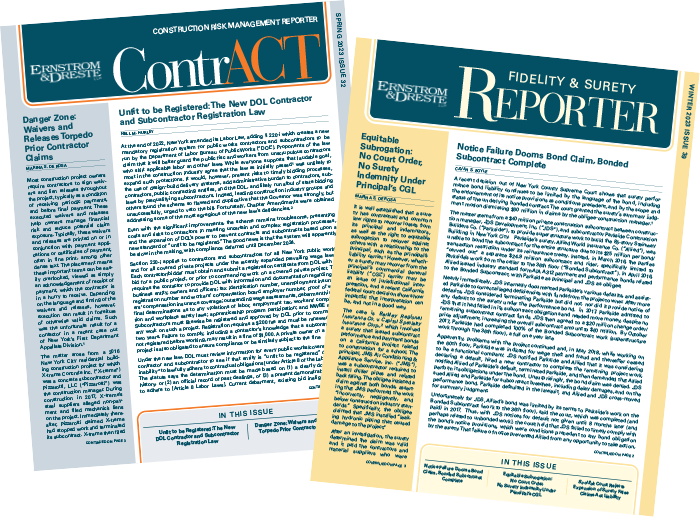Article by: Nell M. Hurley
A New York federal court recently held that the 2022 Construction Industry Wage Theft Act (“Wage Theft Act”)1 was preempted by federal law for claims against the general contractor for its subcontractor’s unpaid workers’ benefits.2
State laws increasingly expand general contractor liability to unsatisfied obligations of downstream subcontractors for employee wages and benefits. New York’s prevailing wage laws impose such liability in public construction. The Wage Theft Act, applicable to private projects, makes the GC jointly and severally liable for a lower-tiered contractor’s failure to pay its workers’ wages and benefits and authorizes third-party beneficiaries to sue to collect. This new case illustrates limits to the use of such state laws where federal law creates the underlying obligation.
The representative of certain union benefits funds (“Finkel”) sued general contractor Structure Tone in state court for $2.8 million in benefits contributions its sub failed to pay workers, citing the Wage Theft Act. Structure Tone removed the case to federal court, arguing that ERISA (and/or LMRA)3 apply exclusively to the claims and preempt state statutory claims. Finkel disagreed and moved for a remand to state court or to amend its pleadings to bring federal claims against Structure Tone. Structure Tone opposed and sought denial of the amendment.
In a matter of first impression, the federal court denied Finkel’s motions and granted Structure Tone judgment dismissing the state claims finding:
…when a collective bargaining agreement establishes an employer’s obligations to contribute to a benefit fund, ERISA and the LMRA each preempt an action asserted under [New York’s Wage Theft Act] to collect a subcontractor’s delinquent fund contributions from a general contractor.
Per the court, Finkel’s proposed amended federal claims failed because recovery of delinquent contributions is only authorized against those with a direct contractual obligation for them, such as a collective bargaining agreement (“CBA”), which Structure Tone did not have.
ERISA is intended to provide a uniform regulatory regime for employee benefits plans and eliminate the threat of conflicting or inconsistent regulation.4 State statutory claims within the scope of ERISA’s civil enforcement provisions must be removed to federal court since ERISA “…completely preempts any state law cause of action that duplicates, supplements or supplants the ERISA civil enforcement remedy,” the court noted.
The decision focused on case law interpreting the application of ERISA preemption, finding: Finkel was the type of party, and Wage Theft Act claims were the type of claims, covered by ERISA; and ERISA not only precludes state law claims that directly parallel those enumerated, but also those ERISA omits, including an action against a GC for a subcontractor’s delinquent contributions.
Next, the court assessed whether the state claims were based upon an “independent legal duty” that functions irrespective of the existence of an ERISA plan, ultimately concluding that they were not:
“The law that makes [the subcontractor’s] contributions “required” – or as [Finkel] describes them, “delinquent”…is not [the Wage Theft Act], but [ERISA]….[The Wage Theft Act] depends on ERISA to create the contribution obligation and is thus not independent of ERISA.”
In rejecting Finkel’s claim that the right to payment [from Structure Tone under the Wage Theft Act] was already established, the court relied upon the important distinction between recovery on “existing state-law debts that happen to be based on ERISA obligations5 and actions that require the establishment of an ERISA obligation to prevail. Without a judgment or other debt instrument to support the subcontractor-debt element of its Wage Theft Act claim, the court concluded, it is ERISA that creates the contribution obligation and thus preemption is warranted.6 Since Structure Tone was not bound to the sub’s CBA, no ERISA or LMRA claim exists against it.
The case applies only to claims against a GC where the sub is delinquent in benefits contributions under the sub’s CBA. The holding relates to ERISA benefits, not to wages for labor, or any non-ERISA benefits. Finally, while the reasoning of the decision appears sound, the case is unreported, was not appealed, and thus promises little precedential potential. Any expansion of this finding to other joint and several liability state laws and enforcement must await future court decisions or legislation. Careful vetting of subcontractors remains paramount.
- New York Labor Law § 198-e.
- Finkel v. Structure Tone, LLC, 23-CV-1269 (VSB), 2025 Westlaw 1237411 (S.D.N.Y. Apr. 29, 2025) (unpublished).
- Employee Retirement Income Security Act and Labor Management Relations Act.
- Also called “alternative enforcement mechanisms,” this means a state law cannot be used where ERISA created the exposure and remedy.
- A garnishment action after a court judgment or an action to enforce a surety’s bond payment obligation (basis is contractual agreement, not ERISA).
- Seemingly similar state prevailing wage enforcement actions (under N.Y. Labor Law §§ 220 and 223) were not preempted where the obligation was found to arise “directly under” the state statute.



